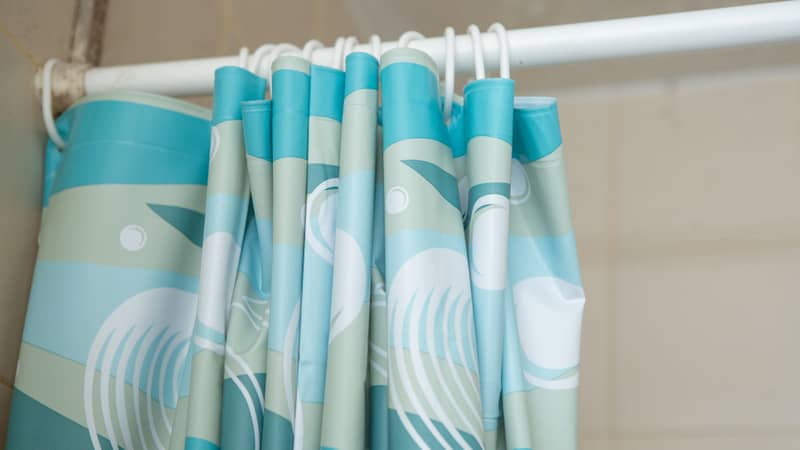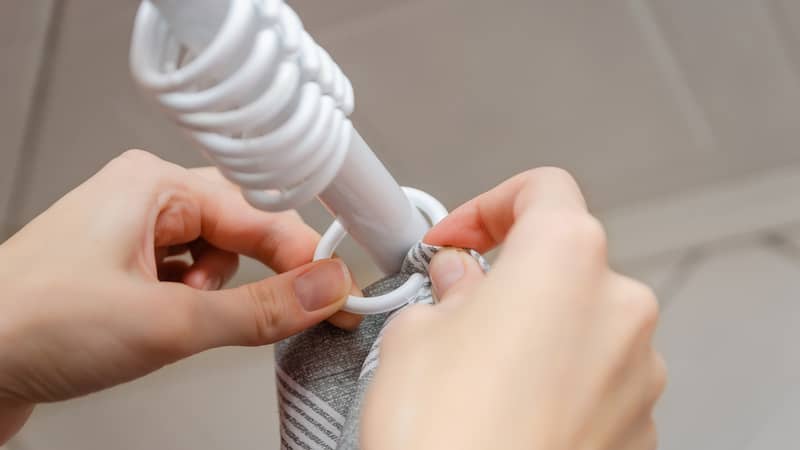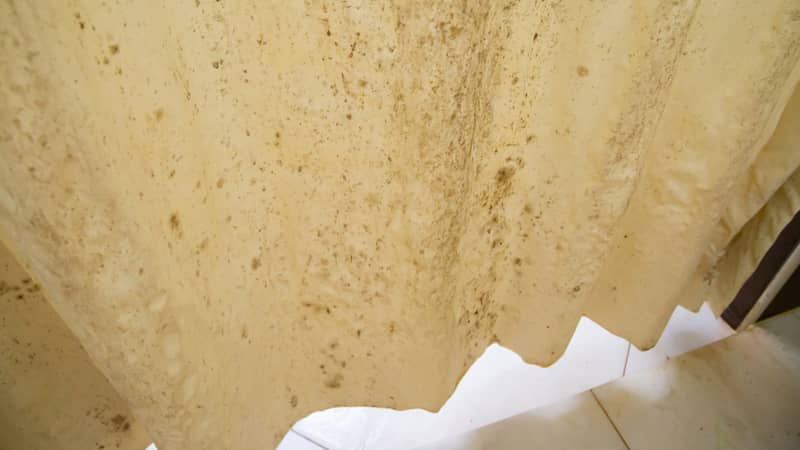The list of things to clean in a bathroom can feel never-ending, but every task is necessary! And that includes everything from scrubbing the toilet to decluttering the counter… to cleaning a shower curtain and liner.
Yep, you gotta tackle those, too.
How to clean a shower curtain and shower liner? You can use a few methods:
- Cleaning with a washing machine
- Cleaning by hand washing
- Cleaning without taking the curtain or liner down
Whichever method you choose to wash the curtains and liners, don’t put them in a dryer! Just hang them back up to air dry either in the bathroom or out in the sun.
Now get those curtains and get cleaning!
Shower Curtains vs. Shower Liners

You may see these terms used interchangeably, but they’re not the same thing!
A shower curtain will hang outside your shower or tub. It’s more for privacy or decor, since it’s less effective at keeping water out.
Meanwhile, a shower liner (or shower curtain liner) hangs on the inside of your shower or tub. It’s made of more durable materials such as polyester or vinyl, which are both waterproof.
A shower liner will keep water from splashing out of the stall or tub and making a mess on your bathroom floor.
Do you need both a curtain and a liner? Not necessarily, but it’s the ideal setup! However, you can get opaque shower liners that’ll allow you to stick with just one.
How Often to Clean a Shower Curtain and Liner
Soap scum, mineral deposits, and other dirt build up on your shower curtain and liner pretty quickly!
Ideally, you should deep clean (aka wash) shower curtains and liners once a month.
In between washing, you can spray the curtain and liner with some vinegar and quickly wipe down the surface. This will help deter mould or mildew and lessen the soap scum build-up.
You can integrate the curtains and liners into your usual shower cleaning routine, or ask your pro cleaner to wipe them while they work on your bathroom.
How to Clean a Shower Curtain in the Washing Machine
Most shower curtains are machine washable, but make sure to check the care tag first.
Never machine wash a shower curtain with the rings attached. This will damage both the curtain and washing machine.
Either remove the rings first, or wash the curtains by hand.
How to machine wash a plastic shower curtain

To machine wash plastic shower curtains, run a cold cycle.
Use a mild detergent and add a few towels to absorb some of the water.
You can add some vinegar to the rinse cycle for mould or mildew prevention.
How to machine wash a fabric shower curtain
Fabric shower curtains should be washed on a gentle cycle and warm water.
Use a mild detergent and, like plastic curtains, you can add vinegar to the rinse cycle.
How to machine wash a vinyl shower curtain
Vinyl shower curtains are similar to plastic ones because they’re both made from durable and waterproof materials.
You can clean vinyl curtains in a similar way to plastic ones.
Run them through a cold cycle with some mild detergent, and toss in a towel or two to absorb water.
How to Hand Wash a Shower Curtain
If you’d rather skip the machine washing, shower curtains are straightforward enough to wash by hand! This works for any type of curtain material.
Fill the bathtub or sink with warm water, then add some laundry detergent. You can toss in 1/4 to 1/2 cup of baking soda as well, then mix until sudsy.
Place the entire shower curtain into the water until fully submerged. Swish it around and agitate manually, or use a soft-bristled brush to scrub the material.
Drain the tub then rinse the shower curtain in clean water. Hang it back up and spread it wide to air dry.
How to Dry a Shower Curtain or Liner

Avoid putting shower curtains in the dryer. The heat could warp or otherwise damage the material.
Instead, hang the shower curtain back up and let it air dry.
Switch on the exhaust or open the windows, and make sure the curtains are fully opened.
How to Clean a Shower Curtain Without Taking It Down
Use this method if you can’t do a full wash or just need a quick clean.
Mix equal parts vinegar and water in a spray bottle. Saturate the curtains and let the vinegar solution sit for a few minutes.
Wipe the curtain dry with a microfibre cloth.
How to Clean a Shower Liner
Shower liners typically come in more durable materials such as polyester or vinyl. They’re more waterproof and easy to clean.
Much like a shower curtain, you can machine wash a shower liner. Use a delicate cycle and warm water.
Put in your usual laundry detergent and let the cycle run. You can add some vinegar to the rinse cycle to cut through any mould and soap scum.
Alternatively, hand wash the shower curtain liner in a tub with some detergent and warm water.
Hang the shower curtain liners to air dry.
How to Clean Shower Curtain Rings

Plastic shower curtain rings are easy to clean – you can let them soak in a bowl with vinegar and warm water. Rinse them briefly afterwards, then dry with a towel.
Alternatively, wipe them with a good all-purpose cleaner.
If you have metal rings, simply wipe them with some water to remove any surface dirt.
For metal rings that have rust, make a paste with baking soda, dish soap, and water. Use an old toothbrush to apply the paste to the rings and scrub off the rust.
If the rust persists, soak the rings overnight in vinegar then repeat the baking soda scrub in the morning.
TIP: Don’t forget to wipe the shower rod as well!
How to Get Rid of Mould On a Shower Curtain or Liner
Bathrooms are great environments for mould or mildew – enclosed spaces with plenty of dampness or moisture.
Regular cleaning and good ventilation can prevent mould to some extent. However, if you see any mould or mildew spots on your curtains or liners, get on it ASAP!
Also, if there’s mould on your curtain or liner, chances are it could be in other areas. Do a quick check so you can get rid of mould in your shower as well.
Removing mould using hydrogen peroxide
This method works best on vinyl or plastic shower curtains. Mix two parts hydrogen peroxide to one part water in a spray bottle.
Saturate the affected area, then let the solution sit for up to 10 minutes. Rinse the curtain or liner then let it air dry.
Removing mould using white vinegar

Vinegar is a more natural solution for removing mould or mildew. It’s best for fabric curtains since it’s less harsh on the fibres.
Simply soak or saturate the curtain or liner in undiluted vinegar for 30-60 minutes. Rinse afterwards, or put the material through a quick wash cycle.
Hang up the curtain or liner to dry, either in a well-ventilated room or out in the sun.
Removing mould using bleach
Bleach is the strongest cleaning solution against bleach, but be careful while using it! Wear protective equipment such as rubber gloves and a face mask.
One method is to add half a cup of colour-safe oxygen bleach to the wash cycle to kill off any mould.
Alternatively, dilute the bleach in water based on the packaging. Soak the curtains/liners or spray the bleach solution for up to 30 minutes, then rinse thoroughly.
NOTE: If you’re cleaning with bleach, never mix it with vinegar or use bleach after vinegar. It’ll create a chemical reaction that’s dangerous for your health.
Other Shower Curtain and Liner FAQs

Here are some other tips and things to know about cleaning shower curtains and liners!
How can I prevent mould or mildew on the curtain and liner?
Keep a spray bottle with a vinegar mixture handy in the shower. You can use it to clean the shower curtain or liner – and it’s also great for cleaning shower glass!
Alternatively, use a good shower spray, such as the Method Daily Shower Spray or Astonish Daily Shower Shine. It’ll cut through any soap scum and mineral deposits, and help prevent mould.
How often should I replace a shower curtain or liner?
A good shower curtain or shower liner can last months if you maintain it properly.
So long as there isn’t any severe mould or mildew (meaning you can’t clean it off) and it’s in good condition, there’s no need to replace either the curtain or liner.
You can replace your shower curtain or shower liner around once a year.
What are the best materials for shower curtains and liners?
For shower liners, look for vinyl or polyester that has no PVC. For vinyl liners, a good alternative is PEVA, as it’s the safer alternative to PVC.
For shower curtains, there are several options. Plastic shower curtains are affordable and waterproof, but less eco-friendly and can become brittle over time.
Meanwhile, fabric curtains are more versatile and environmentally friendly. Cotton is common and affordable, while help is more eco-friendly and durable.
However, fabric isn’t waterproof and absorbs moisture, so it’s prone to mould.

